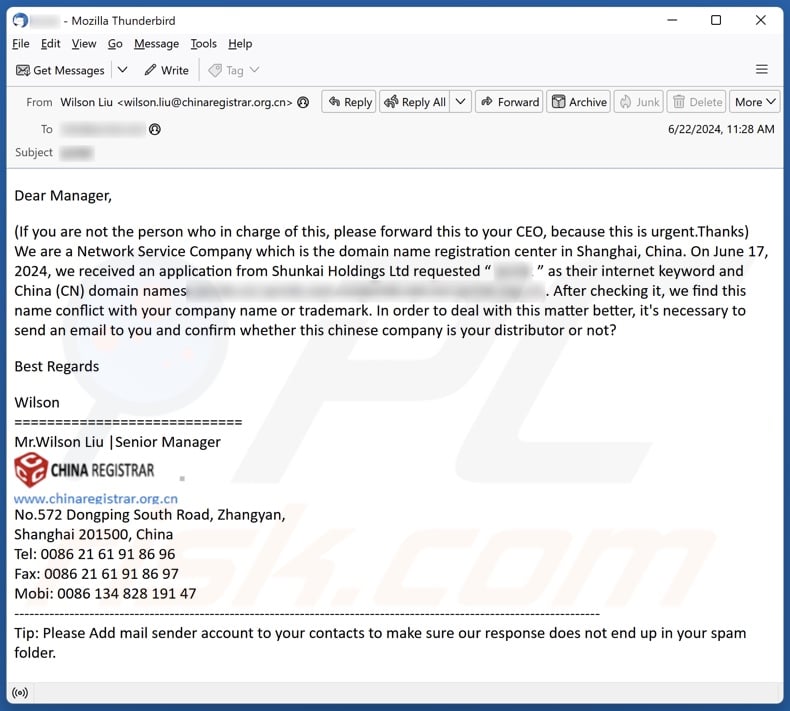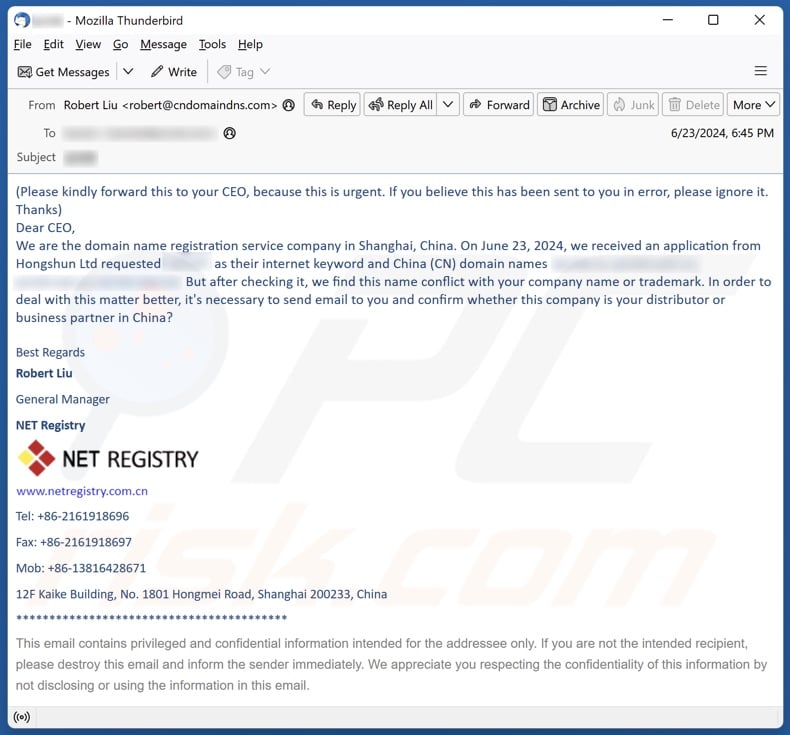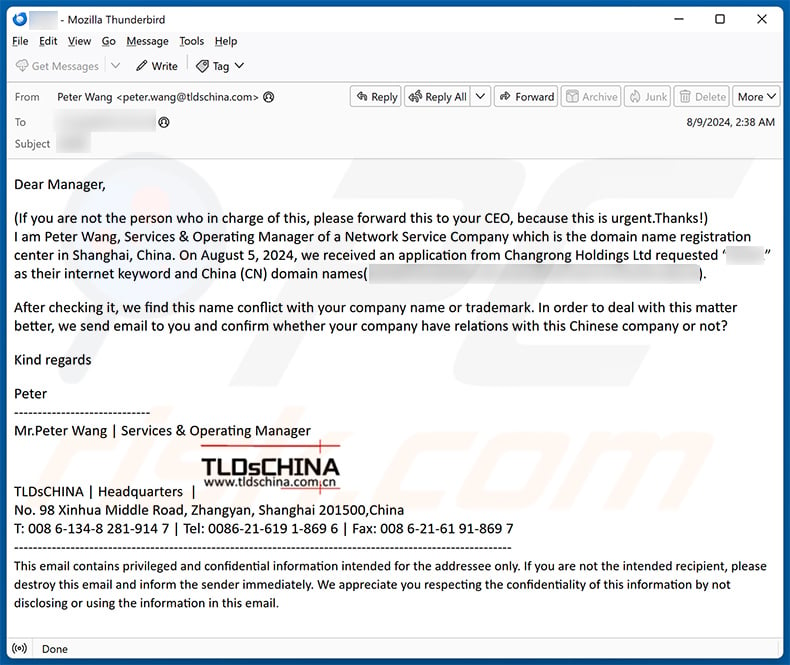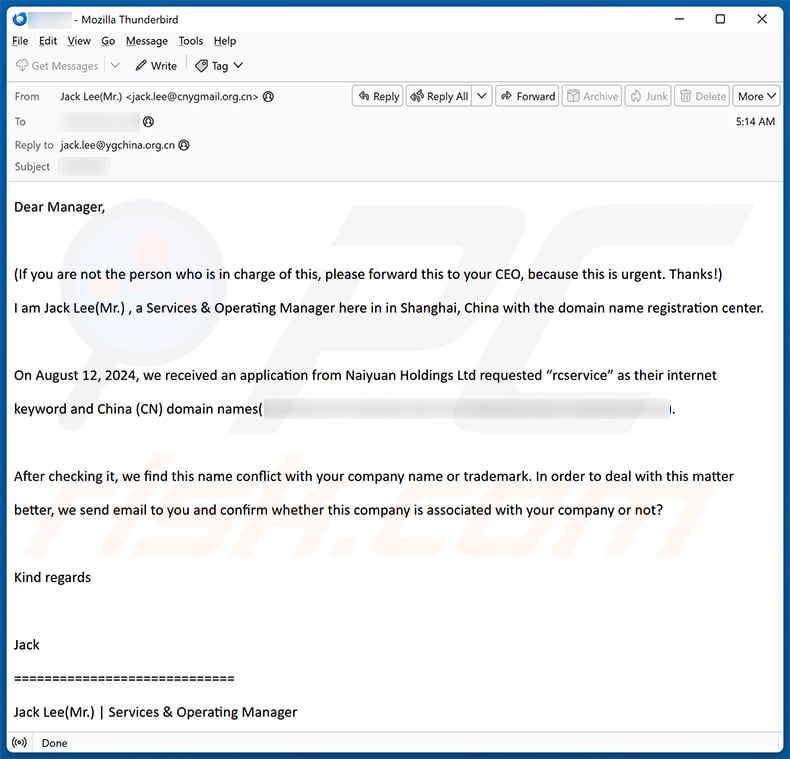Do not trust fake "Conflict With Your Company Name Or Trademark" emails
Phishing/ScamAlso Known As: "Conflict With Your Company Name Or Trademark" domain name scam email
Get free scan and check if your device is infected.
Remove it nowTo use full-featured product, you have to purchase a license for Combo Cleaner. Seven days free trial available. Combo Cleaner is owned and operated by RCS LT, the parent company of PCRisk.com.
What kind of email is "Conflict With Your Company Name Or Trademark"?
After investigating several "Conflict With Your Company Name Or Trademark" emails, we determined that they are spam. These fake letters claim that a registration attempt has been made with the .cn domain that includes keywords associated with recipients' company names or trademarks. The purpose of this spam mail is to promote a domain name scam, specifically – a domain name registration scam.

"Conflict With Your Company Name Or Trademark" email scam overview
The "Conflict With Your Company Name Or Trademark" emails typically state that the message is from a "network service", "domain name registration service", or another relevant entity, and stress that it is intended for the company CEO.
The letters claim that an application has been received to register a .cn domain (country code top-level domain for China), but it was discovered that the request conflicts with the recipient's company name/ trademark. The spam emails ask recipients to verify whether the application was submitted on their behalf by a Chinese distributor or other business partner.
It must be emphasized that all the information provided in these letters is false, and this mail is not associated with any genuine service providers or entities.
As mentioned in the introduction, the emails are promoting a domain name registration scam. If a recipient is lured into contacting the scammers (via email, phone call, etc.), they are informed that the process has been halted to ensure the protection of their proprietary rights.
The scheme can operate in several ways. Victims can be deceived into registering the supposedly sought-after domains, and whether they are actually registered through a shady company or merely led through a fake process – this can rack up to thousands on a yearly basis.
Alternatively, the scammers can purchase said domains at the regular rate and pretend to have worked out a deal with the applicants, wherein victims can buy them back for a bloated price.
To summarize, by trusting an email like "Conflict With Your Company Name Or Trademark" – users can experience significant financial losses and potential privacy issues.
| Name | "Conflict With Your Company Name Or Trademark" domain name scam email |
| Threat Type | Phishing, Scam, Social Engineering, Fraud |
| Fake Claim | Application has been received to register a domain that includes the recipient's company name or trademark. |
| Scammer Phone Numbers | 0086 21 61 91 86 96, 0086 134 828 191 47, +86-2161918696, +86-13816428671 |
| Symptoms | Unauthorized online purchases, changed online account passwords, identity theft, illegal access of the computer. |
| Distribution methods | Deceptive emails, rogue online pop-up ads, search engine poisoning techniques, misspelled domains. |
| Damage | Loss of sensitive private information, monetary loss, identity theft. |
| Malware Removal (Windows) |
To eliminate possible malware infections, scan your computer with legitimate antivirus software. Our security researchers recommend using Combo Cleaner. Download Combo CleanerTo use full-featured product, you have to purchase a license for Combo Cleaner. 7 days free trial available. Combo Cleaner is owned and operated by RCS LT, the parent company of PCRisk.com. |
Spam campaigns in general
Spam emails are used to promote various scams, including (but not limited to) phishing, tech support, refund, service subscription renewal/cancellation, sextortion, lottery, inheritance, and so on. This mail is also used to proliferate malware, such as trojans, ransomware, cryptominers, etc.
While the commonly held belief that these emails are poorly crafted and rife with spelling/grammatical errors is not untrue, it is not always the case. Spam mail can be competently made and even believably disguised as messages from legitimate entities (e.g., service providers, companies, organizations, institutions, authorities, etc.).
We have investigated thousands of spam emails; "Account Password Needs To Be Reset", "Chase - Access Restricted", "SSL Port Server Errors", "Zoom Antivirus Plus Subscription", "Someone Added You As Their Recovery", "Fund Transaction", "Por Este Medio Notifico La Presente Demanda", and "Products We Want To Purchase" are merely some of our newest articles.
How do spam campaigns infect computers?
Cyber criminals commonly use spam campaigns to distribute malware. The emails/messages can include infectious files as attachments or download links. These files come in various formats, e.g., documents (PDF, Microsoft Office, Microsoft OneNote, etc.), archives (RAR, ZIP, etc.), executables (.exe, .run, etc.), JavaScript, and so on.
Once a malicious file is opened – the infection process is initiated. However, some formats need additional user interaction to jumpstart malware download/installation. For example, Microsoft Office files require users to enable macro commands (i.e., editing/content), while OneNote documents need them to click embedded links or files.
How to avoid installation of malware?
We strongly recommend approaching incoming emails and other messages with caution. Attachments or links found in suspicious/relevant mail must not be opened, as they can be harmful or virulent.
However, malware is not spread only through spam mail. Therefore, we advise vigilance while browsing, as fraudulent and dangerous online content typically appears genuine and harmless.
Furthermore, all downloads must be made from official and verified channels. Another recommendation is to activate and update software using legitimate functions/tools, as illegal activation tools ("cracks") and third-party updaters may contain malware.
It is paramount for device integrity and user safety to have a reputable anti-virus installed and kept up-to-date. Security programs must be used to run regular systems scans and to remove detected threats. If you've already opened malicious attachments, we recommend running a scan with Combo Cleaner Antivirus for Windows to automatically eliminate infiltrated malware.
Text presented in the "Conflict With Your Company Name Or Trademark" spam email letter:
Subject: ********
******** domain and keyword in CN
Dear Manager,
(If you are not the person who in charge of this, please forward this to your CEO, because this is urgent.Thanks)
We are a Network Service Company which is the domain name registration center in Shanghai, China. On June 17, 2024, we received an application from Shunkai Holdings Ltd requested “ ******** ” as their internet keyword and China (CN) domain names( ********.cn/ ********.com.cn/********.net.cn/ ********.org.cn). After checking it, we find this name conflict with your company name or trademark. In order to deal with this matter better, it's necessary to send an email to you and confirm whether this chinese company is your distributor or not?
Best Regards
Wilson
============================
Mr.Wilson Liu |Senior Manager
No.572 Dongping South Road, Zhangyan,
Shanghai 201500, China
Tel: 0086 21 61 91 86 96
Fax: 0086 21 61 91 86 97
Mobi: 0086 134 828 191 47
--------------------------------------------------
Tip: Please Add mail sender account to your contacts to make sure our response does not end up in your spam folder.
Screenshot of another variant of this spam email:

Text presented in this email variant:
Subject: ********
(Please kindly forward this to your CEO, because this is urgent. If you believe this has been sent to you in error, please ignore it. Thanks)
Dear CEO,
We are the domain name registration service company in Shanghai, China. On June 23, 2024, we received an application from Hongshun Ltd requested "********" as their internet keyword and China (CN) domain names (********.cn, ********.com.cn, ********.net.cn, ********.org.cn). But after checking it, we find this name conflict with your company name or trademark. In order to deal with this matter better, it's necessary to send email to you and confirm whether this company is your distributor or business partner in China?
Best Regards
Robert Liu
General Manager
NET Registry
Tel: +86-2161918696
Fax: +86-2161918697
Mob: +86-13816428671
12F Kaike Building, No. 1801 Hongmei Road, Shanghai 200233, China
Another example of an email from "Conflict With Your Company Name Or Trademark" spam campaign:

Text presented within:
Dear Manager,
(If you are not the person who in charge of this, please forward this to your CEO, because this is urgent.Thanks!)
I am Peter Wang, Services & Operating Manager of a Network Service Company which is the domain name registration center in Shanghai, China. On August 5, 2024, we received an application from Changrong Holdings Ltd requested “-” as their internet keyword and China (CN) domain names( -).After checking it, we find this name conflict with your company name or trademark. In order to deal with this matter better, we send email to you and confirm whether your company have relations with this Chinese company or not?
Kind regards
Peter
-----------------------------
Mr.Peter Wang | Services & Operating Manager
TLDsCHINA | Headquarters |
No. 98 Xinhua Middle Road, Zhangyan, Shanghai 201500,China
T: 008 6-134-8 281-914 7 | Tel: 0086-21-619 1-869 6 | Fax: 008 6-21-61 91-869 7
Yet another example of an email from "Conflict With Your Company Name Or Trademark" spam campaign:

Text presented within:
Dear Manager,
(If you are not the person who is in charge of this, please forward this to your CEO, because this is urgent. Thanks!)I am Jack Lee(Mr.) , a Services & Operating Manager here in in Shanghai, China with the domain name registration center.
On August 12, 2024, we received an application from Naiyuan Holdings Ltd requested “-” as their internetkeyword and China (CN) domain names(-).
After checking it, we find this name conflict with your company name or trademark. In order to deal with this matterbetter, we send email to you and confirm whether this company is associated with your company or not?
Kind regards
Jack=============================
Jack Lee(Mr.) | Services & Operating Manager
No. 98 Xinhua Middle Road, Zhangyan, Shanghai 201500,China
T: 0086-1348-28191-47 | Tel: 0086-21-619-186-96 | Fax: 0086-21-619-186-97
-----------------------------
Tip: Please Add mail sender account to your contacts to make sure our response does not end up in your spam folder.
Instant automatic malware removal:
Manual threat removal might be a lengthy and complicated process that requires advanced IT skills. Combo Cleaner is a professional automatic malware removal tool that is recommended to get rid of malware. Download it by clicking the button below:
DOWNLOAD Combo CleanerBy downloading any software listed on this website you agree to our Privacy Policy and Terms of Use. To use full-featured product, you have to purchase a license for Combo Cleaner. 7 days free trial available. Combo Cleaner is owned and operated by RCS LT, the parent company of PCRisk.com.
Quick menu:
- What is "Conflict With Your Company Name Or Trademark" domain name scam email?
- Types of malicious emails.
- How to spot a malicious email?
- What to do if you fell for an email scam?
Types of malicious emails:
![]() Phishing Emails
Phishing Emails
Most commonly, cybercriminals use deceptive emails to trick Internet users into giving away their sensitive private information, for example, login information for various online services, email accounts, or online banking information.
Such attacks are called phishing. In a phishing attack, cybercriminals usually send an email message with some popular service logo (for example, Microsoft, DHL, Amazon, Netflix), create urgency (wrong shipping address, expired password, etc.), and place a link which they hope their potential victims will click on.
After clicking the link presented in such email message, victims are redirected to a fake website that looks identical or extremely similar to the original one. Victims are then asked to enter their password, credit card details, or some other information that gets stolen by cybercriminals.
![]() Emails with Malicious Attachments
Emails with Malicious Attachments
Another popular attack vector is email spam with malicious attachments that infect users' computers with malware. Malicious attachments usually carry trojans that are capable of stealing passwords, banking information, and other sensitive information.
In such attacks, cybercriminals' main goal is to trick their potential victims into opening an infected email attachment. To achieve this goal, email messages usually talk about recently received invoices, faxes, or voice messages.
If a potential victim falls for the lure and opens the attachment, their computers get infected, and cybercriminals can collect a lot of sensitive information.
While it's a more complicated method to steal personal information (spam filters and antivirus programs usually detect such attempts), if successful, cybercriminals can get a much wider array of data and can collect information for a long period of time.
![]() Sextortion Emails
Sextortion Emails
This is a type of phishing. In this case, users receive an email claiming that a cybercriminal could access the webcam of the potential victim and has a video recording of one's masturbation.
To get rid of the video, victims are asked to pay a ransom (usually using Bitcoin or another cryptocurrency). Nevertheless, all of these claims are false - users who receive such emails should ignore and delete them.
How to spot a malicious email?
While cyber criminals try to make their lure emails look trustworthy, here are some things that you should look for when trying to spot a phishing email:
- Check the sender's ("from") email address: Hover your mouse over the "from" address and check if it's legitimate. For example, if you received an email from Microsoft, be sure to check if the email address is @microsoft.com and not something suspicious like @m1crosoft.com, @microsfot.com, @account-security-noreply.com, etc.
- Check for generic greetings: If the greeting in the email is "Dear user", "Dear @youremail.com", "Dear valued customer", this should raise suspiciousness. Most commonly, companies call you by your name. Lack of this information could signal a phishing attempt.
- Check the links in the email: Hover your mouse over the link presented in the email, if the link that appears seems suspicious, don't click it. For example, if you received an email from Microsoft and the link in the email shows that it will go to firebasestorage.googleapis.com/v0... you shouldn't trust it. It's best not to click any links in the emails but to visit the company website that sent you the email in the first place.
- Don't blindly trust email attachments: Most commonly, legitimate companies will ask you to log in to their website and to view any documents there; if you received an email with an attachment, it's a good idea to scan it with an antivirus application. Infected email attachments are a common attack vector used by cybercriminals.
To minimise the risk of opening phishing and malicious emails we recommend using Combo Cleaner Antivirus for Windows.
Example of a spam email:

What to do if you fell for an email scam?
- If you clicked on a link in a phishing email and entered your password - be sure to change your password as soon as possible. Usually, cybercriminals collect stolen credentials and then sell them to other groups that use them for malicious purposes. If you change your password in a timely manner, there's a chance that criminals won't have enough time to do any damage.
- If you entered your credit card information - contact your bank as soon as possible and explain the situation. There's a good chance that you will need to cancel your compromised credit card and get a new one.
- If you see any signs of identity theft - you should immediately contact the Federal Trade Commission. This institution will collect information about your situation and create a personal recovery plan.
- If you opened a malicious attachment - your computer is probably infected, you should scan it with a reputable antivirus application. For this purpose, we recommend using Combo Cleaner Antivirus for Windows.
- Help other Internet users - report phishing emails to Anti-Phishing Working Group, FBI’s Internet Crime Complaint Center, National Fraud Information Center and U.S. Department of Justice.
Frequently Asked Questions (FAQ)
Why did I receive this email?
Spam emails are not personal, even if they include details relevant to the recipients. Any such information is most likely obtained through publicly available sources or phishing scams. Cyber criminals distribute this mail in large-scale campaigns – hence, thousands of users receive identical or incredibly similar emails.
I have provided my personal information when tricked by this spam email, what should I do?
If you have provided your log-in credentials – change the passwords of all potentially exposed accounts and inform their official support without delay. However, if the disclosed information was of a different personal nature (e.g., passport photos/scans, ID card details, credit card numbers, etc.) – immediately contact the appropriate authorities.
I have read a spam email but didn't open the attachment, is my computer infected?
Reading an email poses no infection threat; devices are compromised when malicious attachments or links are opened/clicked.
I have downloaded and opened a file attached to a spam email, is my computer infected?
If the opened file was an executable (.exe, .run, etc.) – most likely, yes – since these files cause infections almost without fail. However, you might have avoided this if it was a document (.doc, .xls, .pdf, etc.). These formats may need extra interaction (e.g., enabling macros, clicking embedded content, etc.) to initiate malware download/installation processes.
Will Combo Cleaner remove malware infections present in email attachments?
Yes, Combo Cleaner is designed to scan computers and eliminate all kinds of threats. It is capable of detecting and removing most of the known malware infections. Note that sophisticated malicious programs tend to hide deep within systems – hence, performing a full system scan is crucial.
Share:

Tomas Meskauskas
Expert security researcher, professional malware analyst
I am passionate about computer security and technology. I have an experience of over 10 years working in various companies related to computer technical issue solving and Internet security. I have been working as an author and editor for pcrisk.com since 2010. Follow me on Twitter and LinkedIn to stay informed about the latest online security threats.
PCrisk security portal is brought by a company RCS LT.
Joined forces of security researchers help educate computer users about the latest online security threats. More information about the company RCS LT.
Our malware removal guides are free. However, if you want to support us you can send us a donation.
DonatePCrisk security portal is brought by a company RCS LT.
Joined forces of security researchers help educate computer users about the latest online security threats. More information about the company RCS LT.
Our malware removal guides are free. However, if you want to support us you can send us a donation.
Donate
▼ Show Discussion